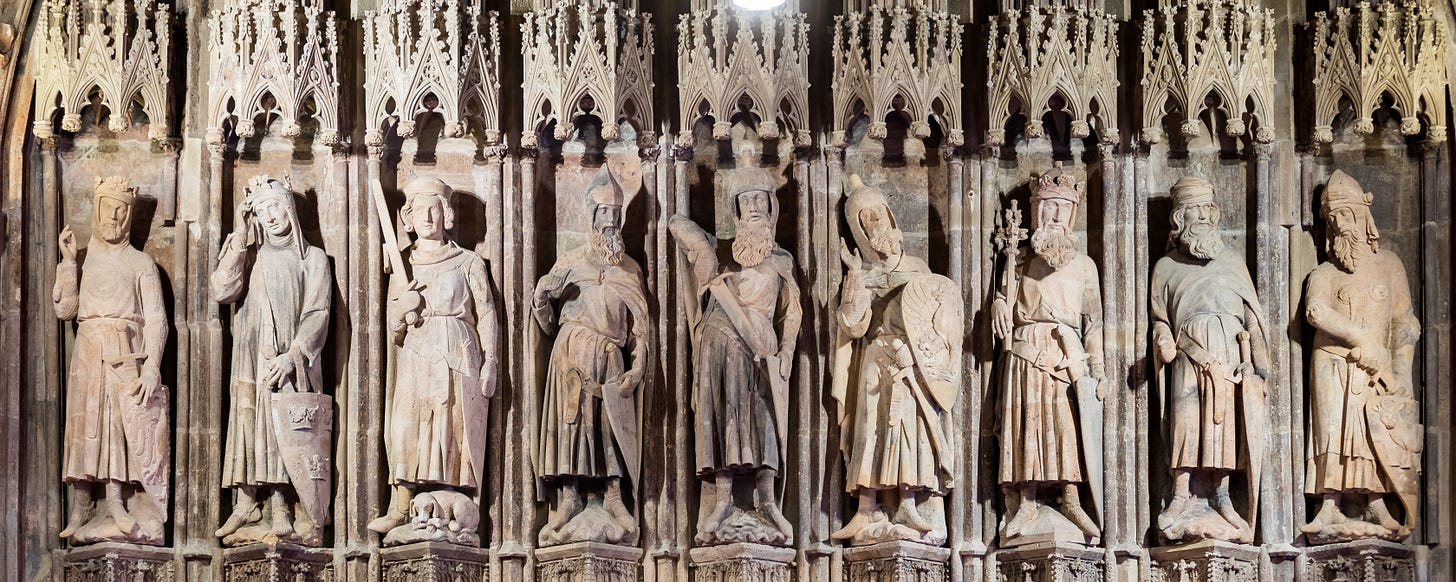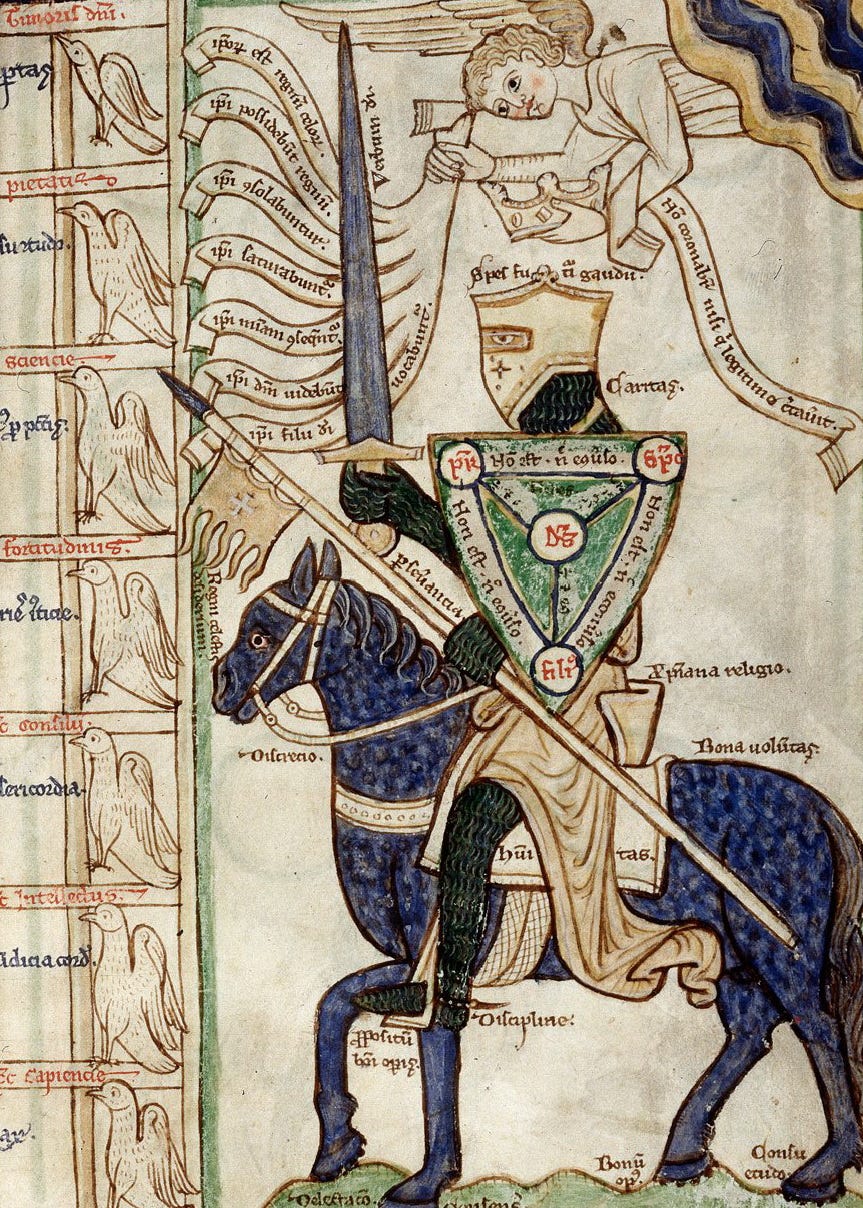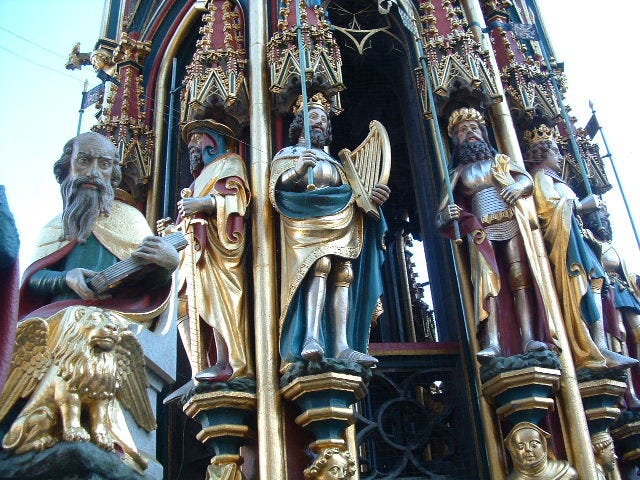Halloo and well met dear readers, and Merry Christmas to you and yours. In my last missive, we explored how the Holy Trinity is reflected in all creation by way of the hylomorphic composite substance of reality being matter, form, and spirit.
Today I’d like to talk to you about something else. Specifically, I’d like to talk to you about the nine worthies of Chivalry. Nine, that's an interesting number for a company of heroes don’t you think? Three sets of Three. A Trinity of Trinities. 3 squared. A perfection if you will, of three. Nine is the number of patience and meditation. Nine, being 8 plus 1, is the number of harmony, and inspiration,. Nine is also the number of months of gestation and of the choirs of the angels, perfection and hierarchy are also 9 . Our Lord, all things being accomplished, gave up his ghost at the ninth hour. Resurrected, Our Lord appeared nine times to his apostles.
Nine spiritual gifts of God are enumerated by Saint Paul: wisdom, knowledge, faith, gift of healing, to operate miracles, prophecy, distinguishing spirits, to speak in different kinds of tongues and the gift to interpret them. (1 Co 12:4-11) Saint Paul enumerates also nine fruits of the Spirit: love, joy, peace, patience, kindness, goodness, trustfulness, gentleness, and self-control. (Ga 5:22).
I could go on at length, but the point dear listeners, is that it is not accidental that there are nine worthies and not eight and not ten, but who are these worthies and what do they mean?

Writing in the early 14th century, Jacques de Longuyon presented three triads of warrior heroes as models of chivalry in his chanson, Les Voeux du paon ("The Vows of the Peacock"). The Nine Worthies, or Les Neuf Preux or "Nine Valiants" in French, as they were called, became a common and enduring theme in Western Europe, represented in art works and literature through France, England, Germany, Spain and Italy.
The first triad comes from the Old Law.
Joshua, who led the Israelites in conquest of the Promised Land
King David, great leader and champion of the Hebrews, founder of the Kingdom of Israel, and ancestor of The Christ.
Judas Maccabeus, the warrior who led the fight against the adaptation of the synagogue to the world of the time, represented by the Seleucids.
The next triad consists of warriors from the Roman or pagan Law.
Hector, brave and virtuous warrior of Troy.
Alexander, conqueror of the entire Known World.
Gaius Julius Caesar, Roman general, conqueror of Gaul and founder of The Empire.
The third triad refers to the New Law that gave birth to Catholic Civilisation, heir of both the Hebrews and Pagans.
King Arthur, who lead the Welsh against the Saxons in their defence of sub-Roman Christendom against invading pagan savagery.
Charlemagne, the Father of Europe, who was crowned Emperor of the Romans due to the vacancy of that title (no, Irene of Athens wasn’t, sorry not sorry) and founded the Holy Roman Empire thereby.
Godfrey de Bouillon, the true crusader and conqueror of the Kingdom of Jerusalem.
Jacques’ schema reflects the medieval view of Salvation History and destiny of Christendom, in that the Old Laws prepared the way for the New. The Pagan law created the Pax Romana that unified the Oikomene of the sons of Japeth and Shem, allowing the Gospel of the New Law to reach them all. While the Hebrews struggled to keep the laws of Moses without falling on the one hand into apostasy or on the other to legalism and self aggrandisement, yet even in their wrestling with their own nature, they produced virtuous flowers, and ultimately, Our Lord. And the medievals saw themselves as the true heirs of both the Hebrews and the Pagans, Japeth and Shem, East and West, and their civilisation as the fulfilment of God’s divine plan.

These nine are archetypes – personifying, embodying the virtues of chivalry: courtesy, loyalty, prowess, hardiness, largesse, honesty, courage, and manliness.
Jacques de Longuyon's conception was in not his own invention, only an elaboration on an existing theme. Earlier texts than his often threw a selection of his heroes together as examples of chivalry, and Philip Mouskes, in his mid 13th-century rhyming chronicle, anticipated his idea by representing the three laws with three heroes – Hector, Judas Maccabeus, and Ogier, the Danish Paladin. Jacques simply expanded the trinity of champions of the laws into a trinity of triads. But this in itself was impressive. His triads symbolise beautifully the three principal ‘chapters’ in chivalrous history, and clarify thereby its place in the broad framework of Christian providential world History.

The three Hebrew heroes remind us that the Old Testament is the story of God's wayward and erring priestly nation, which was the physical vessel of His plan for mankind, and through whose service to the one true God, the way was made ready for the coming of The Christ, and whose royal bloodline flowered with the fruit of Our Lord, True Food giving True life.
Christ's mission, though, was not to the Hebrews only, and the Pagans too had a part too in preparing the way for the New Law. Christ came as the Prince of Peace at that point in time not accidentally but precisely because the Romans had unified the Hellenic world into a cohesive oikomene and established their peace in it. Remember, dear readers, that it was Augustus who made shut the doors of the Temple of Janus, signifying the beginning of his universal peace. It was this Roman peace, built on the achievement of Pagan chivalry – Trojan, Greek, and Roman – that made possible the journeys of the Apostles, their evangelisation of the Gentiles, and the establishment of the Christendom and Holy Empire.
It should also be noted that it was also the Gospel of John (En arche ēn ho Logos, kai ho Logos ēn pros ton Theon, kai Theos ēn o Logos — IN the beginning was the Word, and the Word was with God, and the Word was God) that finished the process begun earlier with the translation of the Old Law into Greek with the Inspired Septuagint; that is the integration of Greek Philosophy with Hebrew Mysticism, Logos and Shekinah. If Israel provided the matter of the New Law in the Person of Our Lord and the Liturgy and iconography of the Church, then the Greek Pagans provide her Form with a sound philosophical foundation and rigorous technical vocabulary.
This then is the Homeric strand in chivalrous history, springing forth from bronze age and pre-history that Hector, Alexander and Caesar remind us about, and its story does not stop short with the apotheosis of Augustus and the closing of that classical age. It was Vespasian and his Roman knights who, by destroying Jerusalem and the Temple, took just vengeance for Our Lord's Regicide. And with the conversion of Constantine the Roman Empire and Christendom became one in a marriage of Church and State, Pagan and Hebrew, Athens and Jerusalem.
Of course, the medieval mind craved, loved, and prised symmetry and order, and if there to be nine worthies, nine exemplars of heroic manhood, Les Neuf Preux… Then there aught to be Les Neuf Preuses, or nine worthy women.

But that’s a Chaplet for another time.
Three Hebrew Heroes of the Old Law
Three Champions of Pagan Virtue
Three Paladins of the New Covenant
Nine Worthies of Chivalry, Soldiers and Saints.
Why Nine? I think, dear readers, you know by now.


